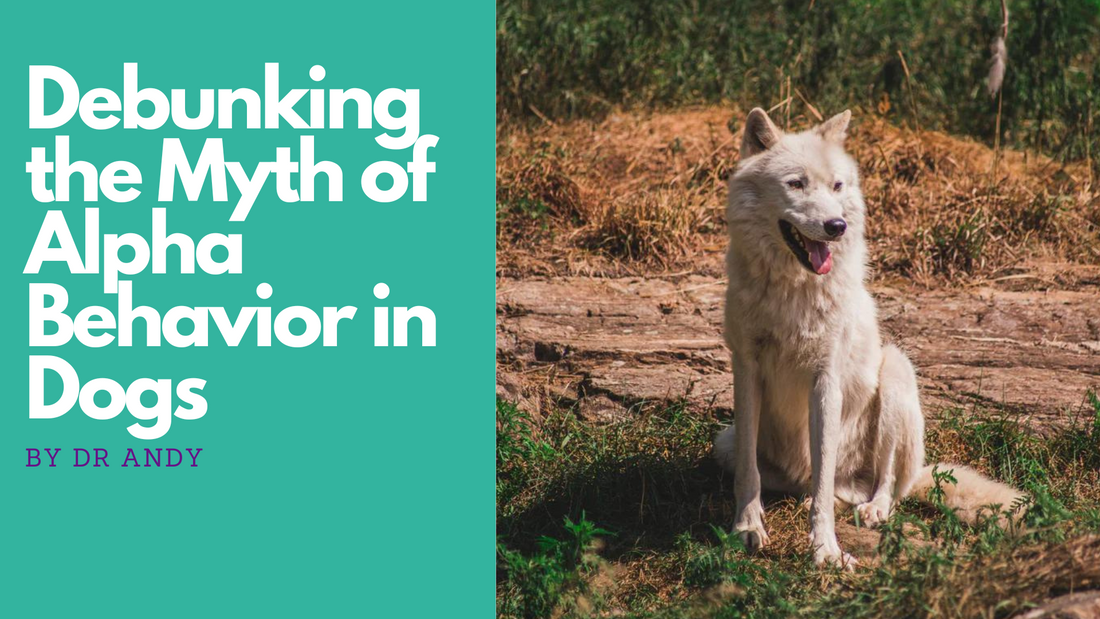In the world of dog training, misconceptions and outdated theories often circulate, fueled by media sensationalism and misguided shortcuts. One persistent notion that has endured for decades is the concept of "Dominance Theory," implying that dogs are driven to establish dominance within human households. However, as our understanding of canine behavior advances, it becomes clear that directly applying now debunked wolf pack dynamics to domestic dogs is a flawed perspective.
In this article, we will delve into the origins of Dominance Theory, its inherent limitations, and explore the path toward a more enlightened and compassionate approach to dog training.
Unraveling Dominance Theory: A Historical Perspective
Dominance Theory traces its roots back to the observations of animal behaviorist Rudolph Schenkel in the 1930s and 1940s. Schenkel's research focused on captive zoo wolves, and it led to the widespread belief that wolves engage in perpetual dominance battles. However, it's crucial to understand the context of Schenkel's studies – they were conducted in an environment far removed from the wolves' natural habitat.
The wolves Schenkel observed were confined to captive settings, an unnatural environment that significantly influenced their behavior. In such constrained conditions, these wolves were forced to interact in ways that diverged from their typical social structures in the wild. The continuous dominance struggles noted by Schenkel were more a result of the stresses and constraints of captivity rather than an accurate representation of wolves' innate behavior.
This critical aspect underscores the flaw in drawing sweeping conclusions about wolf behavior based solely on observations within the confines of captivity. The true nature of wolves in the wild is far more nuanced and complex than the dominance-focused dynamics that Schenkel's studies appeared to suggest. Subsequent research, particularly studies conducted in natural habitats, has provided a more accurate understanding of wolf social structures and debunked the oversimplified notion of constant dominance battles.
Science Corrects the Narrative
In the late 20th century, a transformative shift in our understanding of wolf behavior emerged through David Mech's extensive research on wild wolves in Canada. This groundbreaking work challenged the previously held beliefs perpetuated by Schenkel's observations and, subsequently, Dominance Theory.
Mech's research, conducted from 1986 to 1999, unveiled a starkly different narrative from the one painted by Dominance Theory. In direct contrast to the notion of perpetual dominance battles, Mech demonstrated that wolf packs function as family units. These familial structures are primarily composed of a breeding pair and their offspring. This familial dynamic stands in sharp contrast to the competitive hierarchy suggested by the concept of the alpha wolf.
The concept of the alpha wolf, deeply entrenched in popular wolf literature, faced reconsideration in the wake of Mech's findings. Mech, acknowledging the evolution of scientific knowledge, expressed reservations about the perpetuation of outdated terminology. In his own words, Mech highlighted that the term "alpha" implies a competition-driven hierarchy, a concept that doesn't align with the reality of how wolf packs operate.
In the context of Mech's research, it became clear that the wolves assuming leadership roles within packs achieved these positions primarily through mating and producing offspring. This simple yet profound revelation challenged the traditional notion of an alpha wolf emerging victorious in fierce contests. Instead, Mech emphasized the roles of "breeding males" and "breeding females" or, more neutrally, "male parents" and "female parents." In packs with multiple breeding animals, the term "dominant breeder" was introduced to describe the individual with breeding priority, while other breeding members were designated as "subordinate breeders.”
Mech's research not only reshaped our understanding of wolf dynamics but also dismantled the foundation of Dominance Theory, emphasizing the importance of accurate, context-specific terminology in comprehending the intricacies of wolf behavior.
Applying Knowledge to Dogs
While insights into wolf behavior can offer valuable perspectives on certain aspects of dog behavior, it is paramount to acknowledge that dogs are not wolves. David Mech, a prominent researcher in wolf behavior, has explicitly cautioned against directly applying wolf social structures to domestic dogs. Contemporary experts echo this sentiment and advocate for an approach centered around cooperative care, prioritizing trust and partnership over imposing a rigid hierarchical framework.

The University of Edinburgh's observations further emphasize the distinct social structure of dogs, dispelling the notion of a dominance-driven hierarchy prevalent in wolf packs. Unlike many social animal groups, dogs lack a linear hierarchy, and there is no constant struggle for dominance or an "alpha" position. The following characteristics define their social structure:
- Small Family Groups: Dogs typically form small family groups, often comprising a mother and her pups. These groups tend to stay together until the pups are over a year old.
- Mating and Pups: Dogs don't mate or pair up for life. Female dogs are mated by male dogs, and there is no cooperative raising of pups. The mother usually raises the offspring independently.
- Rare Aggression: Aggression is infrequent, with females displaying increased aggression after giving birth. Dogs, being sociable animals, employ a variety of body language to avoid conflict. Aggressive encounters are usually triggered by a perceived threat, protection of puppies, or guarding important resources.
- Transient Groups Not Packs: Dogs may form relatively transient, short-lived groups of unrelated individuals around food sources, such as human rubbish or food provided by caretakers.
- Play Behavior: Dogs enjoy the company of other dogs and engage in play behavior, especially if their physical, mental, and environmental welfare is optimal. Play activities, including chasing, play fighting, and tugging games, are common among dogs.
- Independent Foraging: Free-roaming dogs do not hunt together for food but forage or scavenge independently. They often rely on human-provided food, either from leftovers or intentionally left out by caregivers.
Understanding the nuanced and varied social behaviors of dogs enables us to develop training and care approaches that align with their true nature, fostering cooperative relationships built on trust and mutual well-being.
Understanding Dominance in Context
Unraveling the intricacies of canine social structures unveils a landscape far removed from persistent dominance myths. Dr. Sophia Yin, a respected authority in the field, accentuates the dynamic and contextual nature of dog hierarchies, dispelling the notion of a rigid social order. The term "dominance" is unraveled as a relative concept, with dogs naturally navigating their roles without a perpetual pursuit of alpha status. Understanding this, it's crucial to recognize that dominance, when displayed, is often transient and closely linked to resources, a fact emphasized by the University of Edinburgh. Dogs form fluid hierarchies influenced by immediate circumstances, challenging the oversimplified view that a singular, rigid structure governs their social interactions.
True leadership in the dog world, as advocated by Dr. Yin, transcends superficial rules like eating order or sleeping arrangements. Effective leaders establish purposeful rules and boundaries, contributing to a harmonious canine social environment.
Behavior Solutions Beyond Dominance
In solving behavior problems, Dr. Yin champions a contextual approach, urging a nuanced exploration of canine actions and their underlying motivations. This enlightened perspective not only dismantles the myths surrounding dominance but fosters a compassionate comprehension of the intricate social dynamics that govern dogs' interactions, fostering healthier relationships between humans and their canine companions.
Addressing individual behavior problems requires leadership, but this leadership is not synonymous with enforcing dominance. It involves understanding the purpose of the behavior, meeting the dog's needs, and fostering positive alternatives. For example, service dogs often share beds and go through doorways first without exhibiting dominance issues.
Unveiling the Pitfalls of Alpha-Dominance Training Methods
In the ever-evolving landscape of pet training, the pervasive influence of dominance theory has led to misguided practices that jeopardize the well-being of our canine companions. Dr. Sophia Yin, a beacon of wisdom in the field, sheds light on the alarming trend where dominance becomes a catch-all explanation for every conceivable behavioral quirk. From puppies playfully tugging at trouser legs to birds exhibiting unexpected flight patterns, the inclination to assert dominance has become a blanket justification for punitive measures.
This misdirection in training methodologies takes a particularly distressing turn when it comes to the misapplied techniques aimed at "dominance reduction." Unfortunately, these approaches range from ineffective to outright hazardous. The attempts to make dogs conform by making them go through doors later or eat after their owners not only fail to address the root of behavioral issues but also risk teaching dogs to anticipate specific actions in isolated situations. More significantly, extreme measures such as pinning dogs to the floor, grabbing their jowls, or deploying startling noise makers emerge as distressing consequences of this alpha-centric mindset.
The fallout of such misapplied dominance practices is witnessed by veterinarians and shelters alike. Driven by the misguided belief in forcing submission, dogs subjected to these techniques often find themselves in a downward spiral of fear, unpredictability, and aggression. As relayed by veterinary behaviorists, the repercussions can be severe, with once docile puppies reaching a breaking point around the age of two, leading to defensive behaviors that endanger both the dog and their owner. The resounding message from experts is clear: it's time to shift away from these harmful practices and embrace alternative, positive reinforcement-based training methods.
Embracing Gentle Leadership: A Departure from Dominance
In steering our approach to canine companionship, let's liberate ourselves from the shackles of dominance-based ideologies. The allure of alpha dog theories has waned in the face of comprehensive studies, urging us to transcend outdated beliefs. As guardians, we wield significant influence over our dogs' lives, naturally assuming a leadership role. However, it's time to shift our focus from enforcing dominance to cultivating bonds rooted in understanding and empathy.
Diving into the fascinating world of canine cognition, Emory University's groundbreaking study reveals the profound depths of our connection with dogs. MRI scans, a testament to their willing participation, illuminate that, among various stimuli, it's the scent of humans that lights up the reward centers in their brains. Dogs perceive us not as dominant figures but as cherished companions. This prompts us to choose a path of gentle leadership akin to the nurturing relationship between a parent and child. Let's move forward with compassion, forging connections that prioritize kindness over coercion in the intricate dance of training and companionship.

